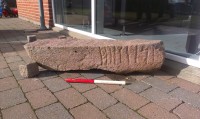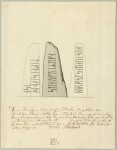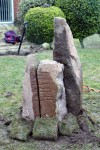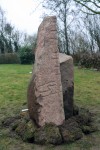 A thousand-year-old runestone missing for 250 years has been found in the garden of a home in the village of Boddum in Thy, northern Jutland, Denmark. It all started in November of 2015 when farmer Ole Kappel called the Museum Thy to report he had a stone with some carved lines on it lying in his garden. He asked for an expert to examine it and tell him what it was. In March, Museum Thy archaeologist Charlotte Boje Andersen and National Museum of Denmark runologist Lisbeth Imer were amazed to find that the stone lying around in Kappel’s garden was the Ydby Runestone, carved between 970 and 1020 A.D. and last seen in 1767.
A thousand-year-old runestone missing for 250 years has been found in the garden of a home in the village of Boddum in Thy, northern Jutland, Denmark. It all started in November of 2015 when farmer Ole Kappel called the Museum Thy to report he had a stone with some carved lines on it lying in his garden. He asked for an expert to examine it and tell him what it was. In March, Museum Thy archaeologist Charlotte Boje Andersen and National Museum of Denmark runologist Lisbeth Imer were amazed to find that the stone lying around in Kappel’s garden was the Ydby Runestone, carved between 970 and 1020 A.D. and last seen in 1767.
“It was one of the biggest moments in my time as an archaeologists and a completely one-of-a-kind discovery that highlights how important Thy and the western part of the Limfjord were in the Viking era,” [Andersen] said.
 The Ydby Runestone was first documented in 1741 by bishop and antiquarian Erik Pontoppidan in the second volume of his collection of notable Danish inscriptions, Marmora Danica. Pontoppidan reported that the stone was moved from a place known as “Hellesager,” where it had stood upright over a triangular underground tomb surrounded by stones, to the village of Flarup. In 1767, Danish naturalist and illustrator Søren Abildgaard tracked down the runestone near Flarup. He made an accurate drawing of stone and the runes on three of its four sides and recorded its location in his travel diary.
The Ydby Runestone was first documented in 1741 by bishop and antiquarian Erik Pontoppidan in the second volume of his collection of notable Danish inscriptions, Marmora Danica. Pontoppidan reported that the stone was moved from a place known as “Hellesager,” where it had stood upright over a triangular underground tomb surrounded by stones, to the village of Flarup. In 1767, Danish naturalist and illustrator Søren Abildgaard tracked down the runestone near Flarup. He made an accurate drawing of stone and the runes on three of its four sides and recorded its location in his travel diary.
After that, the stone disappeared. We don’t know when it was displaced, but landscape painter RH Kruse looked for it assiduously in 1841 and it was no longer there. None of the residents had any information about the runestone. A local farmer told Kruse that as far as he knew, the stone hadn’t been there for 50 years. A teacher named Nissen who was an avid documenter of runestones wrote to the National Museum in 1898 that he’d learned the stone had been used to build a railway bridge and was probably underwater.
 Kruse had the wrong idea, thankfully. Ole Kappel acquired the stone 25 years ago when he bought a farm property and demolished the house. Thankfully he had the presence of mind to salvage what he could, including a pile of old stones from the foundation of the farmhouse. He took some of the stones home and used them in his landscaping. In fact, he told the thrilled experts, there more of the old farmhouse stones in his front yard patio. Andersen and Imer took a look at the pavers and saw two pieces that matched the shape of the runestone. Kappel’s sons Anders and Kristian pried up the two stones and more runes were revealed.
Kruse had the wrong idea, thankfully. Ole Kappel acquired the stone 25 years ago when he bought a farm property and demolished the house. Thankfully he had the presence of mind to salvage what he could, including a pile of old stones from the foundation of the farmhouse. He took some of the stones home and used them in his landscaping. In fact, he told the thrilled experts, there more of the old farmhouse stones in his front yard patio. Andersen and Imer took a look at the pavers and saw two pieces that matched the shape of the runestone. Kappel’s sons Anders and Kristian pried up the two stones and more runes were revealed.
 Imer was able to identify the stone because the extant runes matched the one recorded in Abildgaard’s drawings. Translated into English, it reads: “Thorgísl and Leifi’s sons placed/ at this place/ the stone in memory of Leifi.” Based on the parts that are missing, Imer thinks the stone, which was about six feet high and three feet wide when intact, was broken into about eight sections. All together, the rediscovered pieces form about half of the original runestone.
Imer was able to identify the stone because the extant runes matched the one recorded in Abildgaard’s drawings. Translated into English, it reads: “Thorgísl and Leifi’s sons placed/ at this place/ the stone in memory of Leifi.” Based on the parts that are missing, Imer thinks the stone, which was about six feet high and three feet wide when intact, was broken into about eight sections. All together, the rediscovered pieces form about half of the original runestone.
Andersen has checked the records and she thinks the  stone was swiped in the 1820s when the farm Kappel bought was built. The farm was just a few hundred meters from the runestone’s last known location. The owner appears to have helped himself to the runestone and used it as raw material to build the foundations of his farmhouse. The Kappels plan to keep looking for the other missing pieces.
stone was swiped in the 1820s when the farm Kappel bought was built. The farm was just a few hundred meters from the runestone’s last known location. The owner appears to have helped himself to the runestone and used it as raw material to build the foundations of his farmhouse. The Kappels plan to keep looking for the other missing pieces.
The recovered stones went on display at Heltborg Museum for a month so residents of Thy could see their long-lost cultural patrimony. The stone is now in the National Museum of Denmark where experts will assess whether it should be declared treasure trove. (It should be and will be.)
It is wonderful to see this article. Love it very much! :boogie: